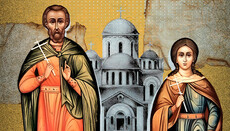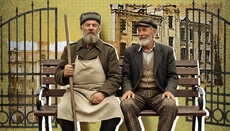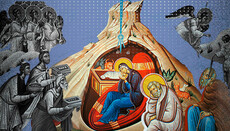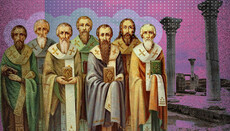"Servility to NKVD and careerism": common between OCU and Renovationists
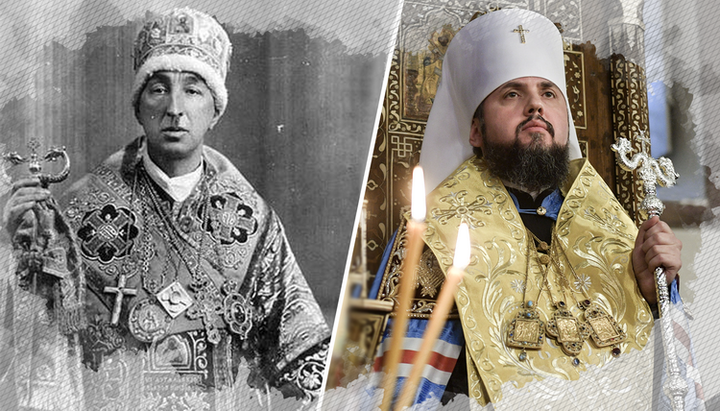
How the Orthodox Church of Ukraine repeats all the steps of its predecessors, the Living Church of the USSR.
Almost every day we learn about the seizures of Orthodox churches by the supporters of the OCU or that a UOC community has moved to a new religious organization created by the President, the Parliament, schismatics, and Patriarch Bartholomew.
This news is as reports from the front. Every day we become witnesses of insults and humiliations against the clergy and believers of the UOC, we see and hear the hierarchy of the Church slandered and defamed. All this not only outrages the Orthodox believers and makes them worry about the fate of the Mother Church but, which is much worse, puts them into depression.
Indeed, everything that is happening reminds of the worst times that our Church had to go through, especially those of a century ago. There are too many parallels not to notice them. They have already been repeatedly described in various church literature (in particular, in great articles by the leading specialist in the history of the Russian Church of the twentieth century, the priest Alexander Mazyrin, which we will quote below). However, in the context of modern Ukrainian realities, it will be useful once again to draw attention to certain interesting and symbolic moments. Indeed, as is known, the one who has not learned the lessons of history is doomed to repeat them.
Emergence of the "Living Church"
In 1917, as a result of the revolution and the armed coup, the power in the Russian Empire was taken by people who destroyed both the empire itself and all the traditions and culture through which it existed. All this happened under the motto "we will our new world".
Under the same slogan, the new power, which later began to call itself the Communist Party of the Bolsheviks, took up the destruction of its main enemy – the Church, as they believed. Almost the first decrees issued by Lenin were related to church and religious issues.
In addition, almost from the very beginning, the Bolsheviks persecuted priests, accusing them of lack of patriotism, loyalty to the new government and anti-revolutionary sentiments. Already in the first years of the “new world” many servants of the altar were shot. The first of these was Metropolitan Vladimir (Bogoyavlensky), whom a crowd of drunken sailors killed at the walls of the Kiev-Pechersk Lavra.
At the same time, the сommunists understood perfectly well that it was possible to achieve some tangible results in the struggle against the Church in only one way - by undermining it from the inside, destroying, so to speak, its heart – faith in Christ. They decided to do this through a group that already existed inside the Church and believed that the Church needed to be renewed or renovated since its traditions, customs, and rites had long been outdated. It is this group that declared its full support for the existing political regime and the reforms and transformations carried out by that government. The main task of the "Renovationists" (as they were called later) was the "modernization" of Russian Orthodoxy and its adaptation to the requirements of the time.
Church renovation or political Orthodoxy?
However, as Father Alexander Mazyrin quite rightly noted, "the main, essential characteristic of the Renovationist schism is not modernism, although it absorbed a certain number of ideological modernists. In reality, the Renovationist schism consisted mostly of people who did not seek any renewal and church reforms, with the possible exception of the married episcopate and the second marriage of the clergy. The Renovationists were largely negatively disposed even to the translation of services into modern languages and practiced the old services, and outwardly tried not to differ from the Orthodox. Their main difference from the "Tikhonovtsi" (Patriarch Tikhon followers – tr.), as the Orthodox began to be called at that time, was their servility to the Soviet authorities, their desire to adapt to it and serve it".
Practically the same point of view is defended by priest Ilya Soloviev: “The main content of the Renovationist schism was not at all in liturgical reforms, but in compromise with the Soviet authorities, in search of a new ‘symphony’ with the state, in adaptation to it. The Renovationists followed the path of the governmentalization of the Church.”
On the other hand, as Father Ilya notes, the Bolsheviks, who actually created the Renovationist "Church", pursued their own tasks: “The most important goal of the main organizers of the schism, the Bolsheviks, was not transformations in the Church, but divisions in it and ‘condemnation of the counterrevolution’."
Orthodox Church in the USSR
Interestingly, until 1922, most of the Renovationists did not seek open confrontation and break with the Church. They existed within the church organization of that time and preached their ideas among Orthodox Christians. Of course, many believers were indignant at their activities and very often wondered why the hierarchy did not react to the clearly anti-Church sermon of future Renovationists.
But in 1922, when the Bolsheviks headed for the physical destruction of the Church, for the realization of this goal, it was decided to make the most of the Renovationists. For this, it was necessary to bring them to the severance with the highest ecclesiastical authority (which is called schism in the Orthodox Church) and, with their help, create an entirely new religious structure that would be totally and completely controlled by state authorities – both in the centre and in the regions.
From the Bolsheviks, this idea was backed by Leo Trotsky, and from the side of the Renovationist Church, it was actively supported by three Petrograd priests who had been under the watchful eye of the Soviet special services for some time.
Their ( Renovationists’ – Ed.) main difference from the "Tikhonovtsi" was their servility to the Soviet authorities, their desire to adapt to it and serve it."
We will not go into the details of the creation of a new "Church", we only say that from 1922 to 1926 the Renovationist movement was the only official Orthodox organization recognized by the RSFSR government (the second such organization in 1926 was the Gregorian schism – the Provisional Supreme Church Council (PSCC)). Interestingly, this religious group called itself the Russian Orthodox Church (although it had no relation to the real Russian Orthodox Church headed by Patriarch Tikhon), but the legal name of this organization was ... the Orthodox Church in the USSR. The similarity with the OCU is more than obvious.
Phanar and schism
But that's not all. The fact is that for some time the Renovationist "Church" was recognized by some Local Orthodox Churches. From the very beginning, it was important for the Renovationists to receive the support of the entire Orthodox world because only so they could justify their own existence and the actual struggle against the canonical Church. That is why they tried by all available means to establish as close as possible relations with the autocephalous Orthodox Churches that existed at that time. And the first in this series, sadly, was the Patriarchate of Constantinople.
Already in the first days of the Renovationist schism, the representative of the Patriarchate of Constantinople in Moscow, Archimandrite Vasili (Dimopulo), concelebrated with the schismatics for the liturgy and took an active part in all renovationist events. The same position was taken by the representative of the Patriarch of Alexandria, Archimandrite Paul (Katapodis). In the end, the Jerusalem Patriarchate joined them. Only the Patriarch of Antioch, who was not in the orbit of the Phanar’s influence at that time, was left out of communication with the schismatics.
"Bon Courage" of Vasili Dimopulo
The personality and activity of Archimandrite Vasili are so interesting (in the context of our talk about comparing what is happening now with what was happening then) that we simply have to dwell on him in more detail.
Father Vasili was a monk and pupil of the Vatopedi Monastery on Mount Athos. From 1924, he was a representative of the Constantinople Patriarchate in the USSR. By that time, the Phanariots had experienced serious harassment from the Turkish government and were ready to seek help even from the leadership of the Soviet Union. Those, in turn, demanded loyalty to the new “Church”.
After some time, Archimandrites Vasili and Paul became honorary members of the Renovationist "Synod" and later were in Eucharistic communion only with the Renovationists. Moreover, there are testimonies that say that Archimandrite Vasili "re-consecrated" for the Soviet "Church" those temples that had been consecrated by Patriarch Tikhon.
On June 1, the Soviet media reported that "the Ecumenical Patriarch removed the former Patriarch Tikhon from the government of the Russian Church". Together with this "ban", the Phanar recognized the Renovationist "Synod" of the Orthodox Church in the USSR. The most interesting thing is that Patriarch Gregory VII explained his decision with a desire to "reestablish peace and unity and end this abnormal condition". He demanded that Patriarch Tikhon should vacate his patriarchal cathedra: "For the sake of reuniting the dissension and for the sake of your flock, you should yield and immediately depart from the government of the Church."
"The main content of the Renovationist schism was not at all in liturgical reforms, but in compromise with the Soviet authorities, in search of a new ‘symphony’ with the state."
In this regard, it is difficult not to recall that even today the Patriarch of Constantinople explains his anti-canonical actions with a desire to achieve peace in Ukraine and “heal the wound of the church schism”, which is tearing apart the Ukrainian society. You can also recall that Metropolitan Onufry received a letter from the Phanar, which clearly states that after the bestowal of the Tomos, he will cease to bear the title of Metropolitan of Kiev and go under the direct jurisdiction of the Ecumenical Patriarchate.
Naturally, Patriarch Tikhon dismissed these ultimatum "wishes" of the Phanar as inappropriate, which, in turn, led to the actual cessation of the Eucharistic communion between him and Patriarch Gregory VII of Constantinople. Thereafter, Archimandrite Vasili communicated and concelebrated only with the Renovationists. It can be assumed that only the closed nature of the young Soviet state prevented the Constantinople Patriarchate from communicating with schismatics at a higher level.
Being the "Church" entirely and completely loyal to the Soviet power, the Renovationists, and in particular Archimandrite Vasili, accused representatives of the so-called “old” canonical Church of being excessively politicized. Referring to the Greek parishes that exist in the USSR, Vasili (Dimopulo) wrote: “In order to avoid sad misunderstandings in the future, I warn all rectors and communities of Greek churches to remember that both the temples and property that make up the national wealth of the USSR were given by the USSR Government for temporarily use, and violating the mutual connection with the Holy Synod and siding the camp of the old churchmen as vividly political, thereby cast unwanted shadows of politicking on themselves, against which the Ecumenical Patriarch himself rises.”
In May 1928, Archimandrite Vasili (Dimopulo) attended the "III Local Holy Council of the Ukrainian Orthodox Autocephalous Church", where he was even elected an honorary member of its presidium.
In the 1930s, when the authorities no longer openly supported the Renovationists and headed for the complete destruction of any religiosity in general, the memoirist and church historian of the twentieth century, Mikhail Gubonin, noted that "nobody went to pray to the Sergius Church in Krapivki (in Krapivensky Lane connecting Petrovka with the passage of Petrovsky Boulevard) at the former Metochion of the Ecumenical Patriarchate in Moscow; people thought Fr. Vasili to be "red", that is, a Renovationist-dissenter, and his usual bluntness and rudeness in dealing with people finally pushed away from him. It seems he was a good drinker, in any case, he always seemed somewhat tipsy or, to put it mildly, ‘a bon courage’. <...> Such was the honoured envoy in Russia, "Kir-Kir" of the Ecumenical Patriarch, known to the whole church Moscow of the 1920s as ‘Sakellarios Vasili’".
Archimandrite Vasili died in 1934 and was buried at the Vagankovo Cemetery. Who performed a funeral service is unknown.
Renovationists – who are they?
It is clear that such a position of the Phanar only aggravated the already complicated church situation in the country. Mass "transfers" began, first among metropolitan and then peripheral communities into the Renovationist Church. Seizures of temples, the massacre of priests who did not wish to enter into communion with dissenters and who did not betray their Church, became commonplace. Local, most often non-church, intellectuals and young Bolsheviks, who successfully performed the functions of modern radicals, took the most active part in the lawlessness.
The number of temples that passed into the hands of the Renovationists was huge. In the 1920s, of the existing 96 temples in Petrograd, only 32 (the rest were closed altogether) belonged to the schismatics. According to approximate estimates by the historian of Renovationism (who himself belonged to this movement for quite a long time) Anatoly Krasnov-Levitin, in 1935 there were 400 renovationist bishops for 280 Orthodox bishops.
The same author gives a rather interesting characteristics to the Renovationists, which, to a large extent, answers the question why many priests betrayed their Church then and betray Her now: "There were no reforms at that time in the Renovationist Church, and most priests went there simply because affiliation with Renovationism was a kind of Habeas corpus act – a guarantee against arrest.
In general, the Renovationist clerics can be divided into four groups: the first — the most numerous group — those same gray priests-officiants who were mentioned above (who came to the Renovationists by accident — Ed.). The second is scoundrels, who joined Renovationism in pursuit of a quick career, rushing to enjoy the "moral freedom" allowed by the Renovationists. Bishop Antonin said about them: "Cesspool barrel of the Orthodox Church." Almost all of them were agents of the GPU. The third is ideological modernists, sincerely striving for the renewal of the Church. These lived half starving, relegated to rundown parishes, pressed by the authorities and their spiritual leaders and not recognized by the people. They almost all ended up in the camps. The fourth is the ideologues of Renovationism – brilliant, talented, ambitious people who came up on the crest of a revolutionary wave. (Church Bonapartes, so to speak). Among them, many (alas!), although not all, were also associated with the GPU.”
OCU as a successor to the “Living Church”
The “ideological modernists”, that is, those who really sought the renewal of the Church, were a minority, as, however, those who worked closely with the GPU. For the most part, those who were simply frightened of repression, or really "scoundrels" - people who were banned in the canonical Church, or wanted to make a quick church career, became Renovationists.
A similar situation is observed now. Many of those who were deprived of the opportunity to worship for specific canonical wrongdoings, first went over to the UOC KP, and then became members of the OCU. In the same way, as some former UOC clerics fell into schism because of the desire to somehow improve their clerical status.
In this regard, we can recall Archimandrite Gabriel Krizina, who, having gone to autocephalists, almost immediately became a bishop, or ex-Metropolitan Simeon (Shostatsky), who hoped that, having joined the schismatics, he would head the new "Church". You can remember many others.
"There were no reforms at that time in the Renovationist Church, and most priests went there simply because affiliation with Renovationism was a kind of Habeas corpus act – a guarantee against arrest."
Many parallels between the church present and the events of a century ago can be seen in the way ordinary believers approached the Renovationists. Let’s refer to the memoirs by Krasnov-Levitin. Here is how he describes the usual "service" performed in the renovation church: "6 pm. Saturday or the eve of the feast. Just as in all churches, the bell rings. On the porch, however, there are almost no beggars: it makes no sense to go here, there are few people here. We enter the temple. Feel depressed. A huge, cold room. And empty. Two dozen parishioners lonely huddle to the altar. There are only a few candles on the chandeliers. And against this dull background, bright vestments, a mitre on the head of a priest, a protodeacon in a kamelaukion look strange. The Renovationist authorities were very generous for awards."
Now one can see the same emptiness and almost no worshipers can be seen in most modern schismatic temples. Even the seemingly iconic "services" are performed practically without the believing people.
For example, during the "enthronement" of Epiphany, the square in front of the Sophia Cathedral was completely empty, in contrast to the cases when state employees were brought to such events.
There are cases when OCU representatives took over an Orthodox church but did not perform a "service" in it due to the absence of those who want to pray.
There are several explanations for this phenomenon: it is difficult to deceive the human heart by slipping various graceless surrogates to it. A truly religious person will not go to seize a temple. Well, most of all, OCU activists are people who have nothing to do with either the Church or the faith in Christ – having seized the temple, they do not go there because they have not prayed before and after they are not going to pray.
Therefore, the conclusion made by Krasnov-Levitin seems completely justified: "Renovationism turned out to be a hoax: instead of the true renewal of the Church, it was servility to the NKVD and careerism."
Indeed, all that is not of God is deception and untruth. And it usually ends sadly and badly for those who believed the father of lies – Satan. Their efforts fade away, and all undertakings crumble and turn into dust.
The Church of Christ will exist until the second coming of the Savior. Yes, perhaps, She won’t be such as now. The number of Christians will be reduced, many temples will close, the faith in God will almost disappear on earth. But there will still be the Church. Because Her Head said: “I will build up My Church, and the gates of hell will not overpower Her.”
So, when we see around that flagrant lawlessness that is happening now, we should not feel desperate and discouraged. Let us better pray to God that we remain in His Church, and all those who left Her may repent and come to find God’s Truth. After all, the All-Merciful Lord wants their salvation too.
